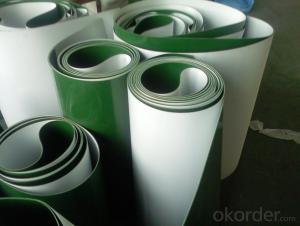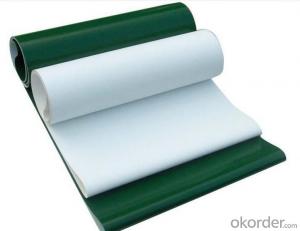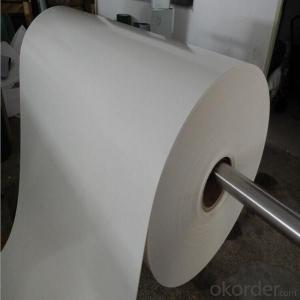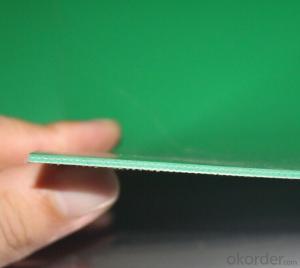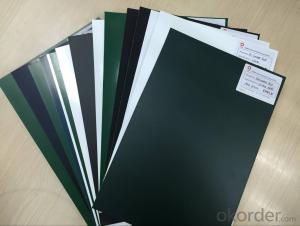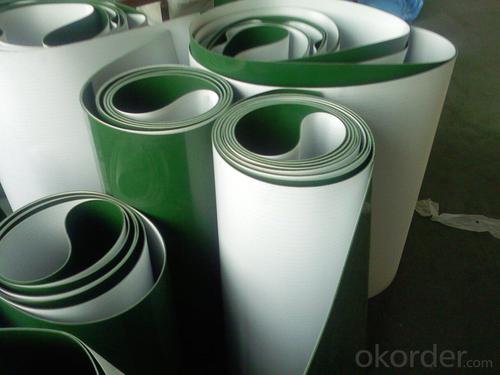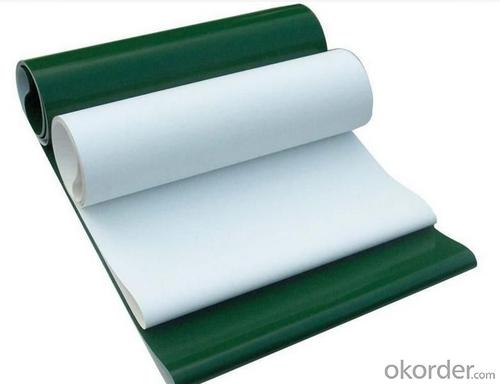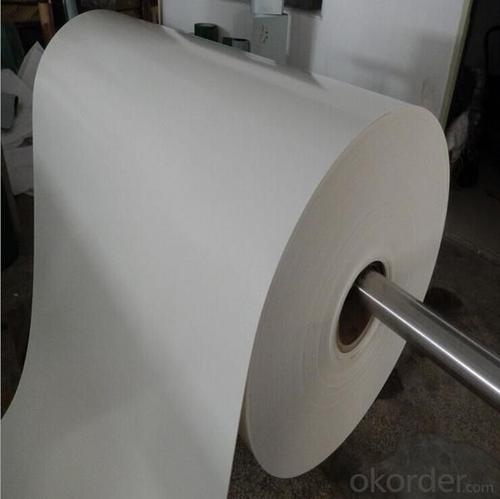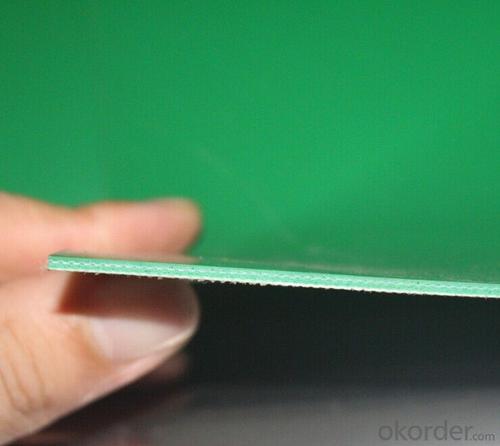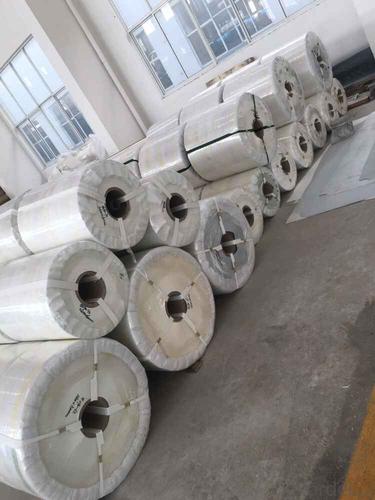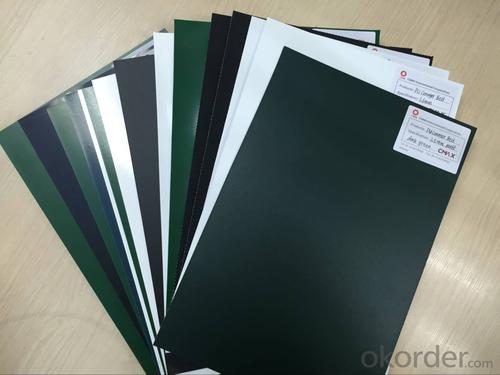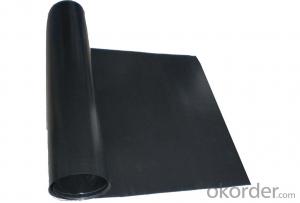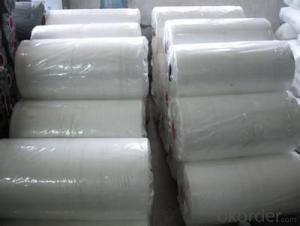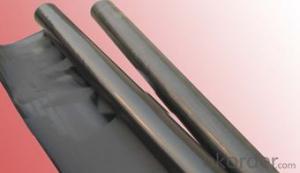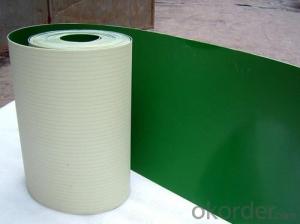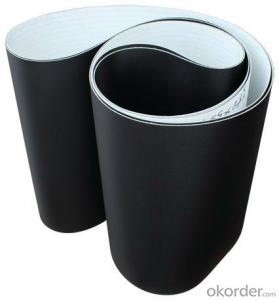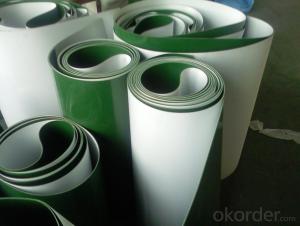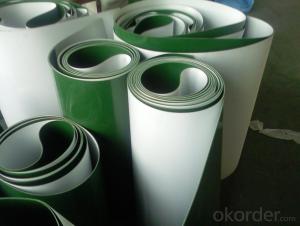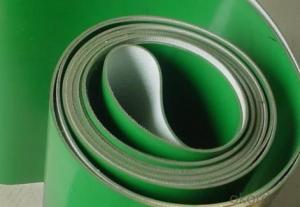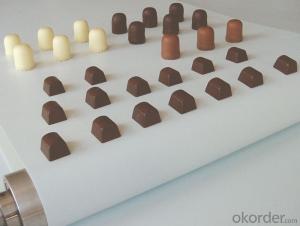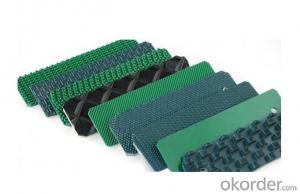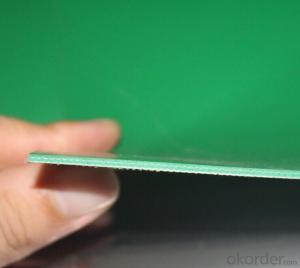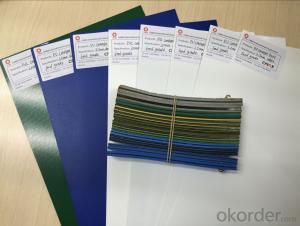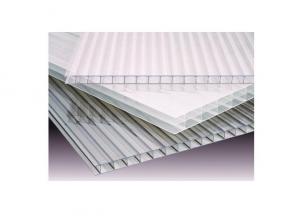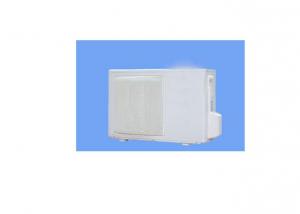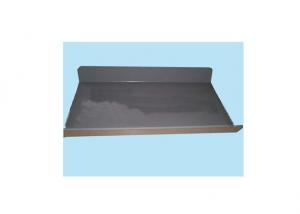Light Duty Green/white/Blue PVC/PU Conveyor belt
- Loading Port:
- China main port
- Payment Terms:
- TT OR LC
- Min Order Qty:
- 10 m²
- Supply Capability:
- 500000 m²/month
OKorder Service Pledge
OKorder Financial Service
You Might Also Like
Light Duty Green/white/Blue PVC/PU Conveyor belt
PVC / PU Conveyor Belt
Light duty conveyor belts are manufactured for all applications with various fabrics impregnation like polyester, nylon, cotton, solid woven, fiberglass etc. Belts are available in different colors like green, white, black, blue and thickness from 0.5 mm to 15 mm up to 3500 mm width and with top surface coating Rubber, PVC, PU, TPU, PE, TPEE, Teflon, Silicone, etc.
The main products include flat surface series, anti-slid series which diversified in a lot of textures for meeting different conveying conditions and environment, featuring anti-static, anti-corrosion, flame retardant etc.
Colors: red, yellow, green, blue, gray, white, black, blue, green, transparent (in general we have)
Thickness: PVC (1~7mm) PU (0.8~4mm)
Appearance: flat surface, diamond pattern, lawn pattern, golf pattern etc.
Advantages: PVC: economical and practical, technology is mature.
PU: applicable to the food industry, abrasion resistant and corrosion.
Subsequent machining technology: it can add baffle, skirt, sponge, guide bar.
Specifications: one ply fabric-one ply PVC, two ply fabric-two ply PVC, three ply fabric-three ply PVC, four ply fabric-four ply PVC
Material: PVC/PU
Tensile strength: 80-300N/mm
Temperature range: -10°C~+90°C
Applications: conveyance and production assembly lines in the areas of cigarettes, foodstuffs, electronics, pharmaceuticals, drinks and papermaking
ADVANTAGES:
Low operating noise and costs, reduced maintenance, excellent durability.
Largely impervious to oils, greases and many chemicals.
Special types give excellent grip on inclination.
Abrasion resistant - rugged, high strength - low stretch characteristic.
Light and thin, better strength / weight ratio - energy saving.
Superb tracking over great length - longitudinally flexible and laterally stiff.
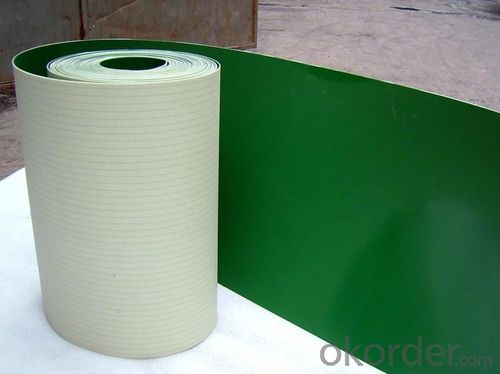
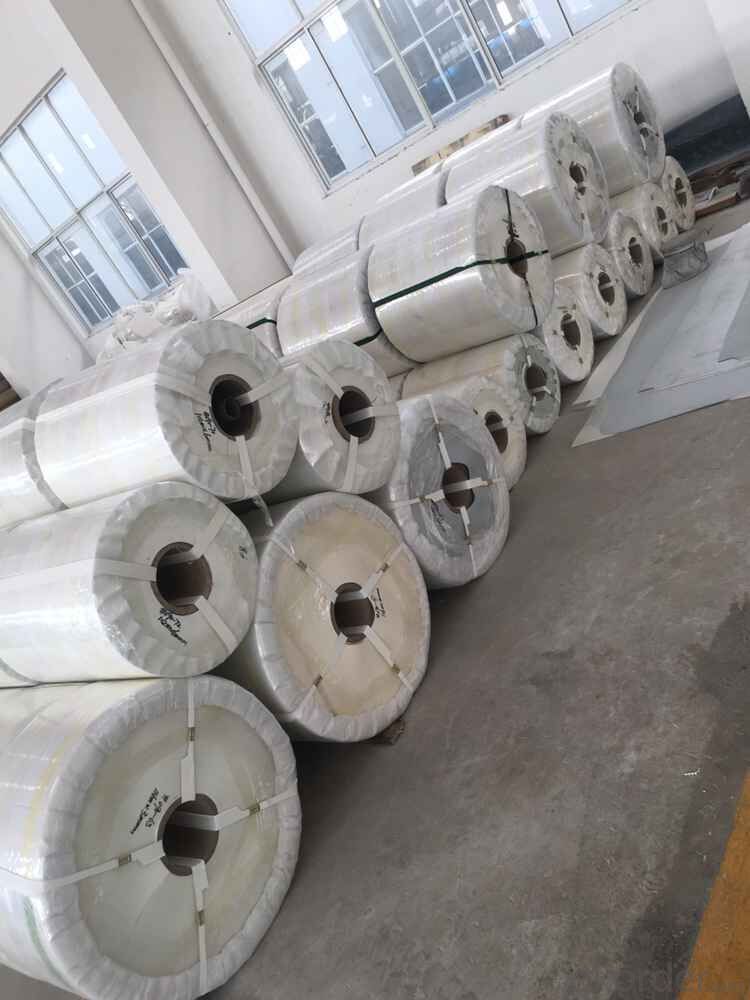

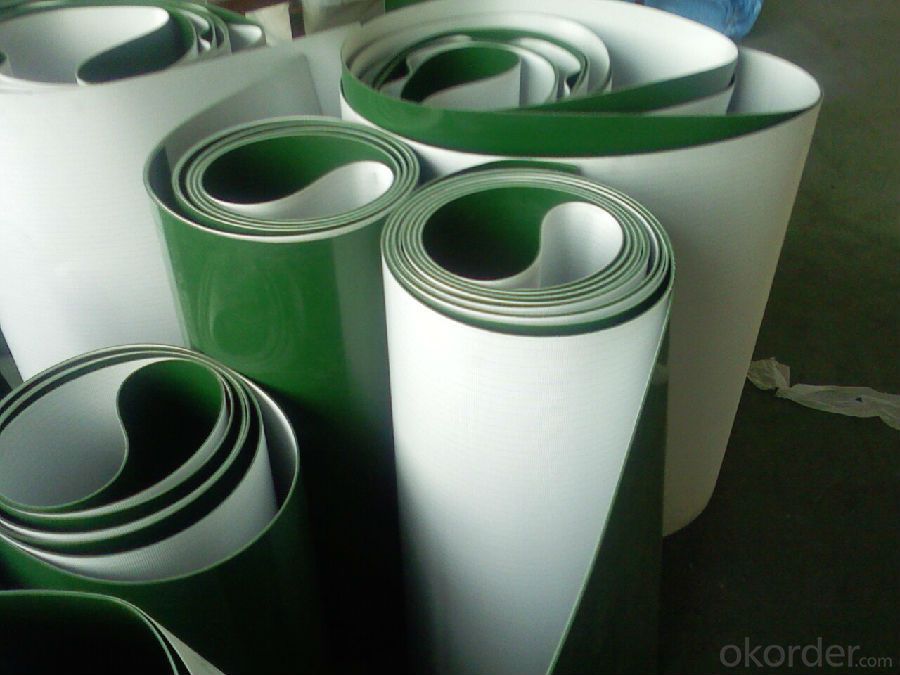
Please contact us freely if you need any conveyor belt.
- Q: How do olive nets affect the overall oil content of the olives?
- Olive nets do not directly affect the overall oil content of the olives. The purpose of olive nets is to collect the olives as they fall from the trees, preventing them from hitting the ground and potentially getting damaged or contaminated. The oil content of olives is mainly determined by factors such as the olive variety, growing conditions, and maturity at the time of harvest.
- Q: What is plastic made of?
- Using petroleum as raw material; transporting the crude oil to the petroleum processing plant for dehydration and desalination, and then fractionating it into various fuel oils such as gasoline, kerosene, diesel, etc.. The preparation of plastic raw materials to a called cracking of oil processing oil, first producing ethylene and propylene raw gas, and then the addition polymerization is made: this material called polyethylene and polypropylene resin. Then hot processing is made of various materials called polyethylene plastics and polypropylene plastics
- Q: How do you know when it's the right time to install olive nets?
- The right time to install olive nets typically depends on the stage of olive tree growth and the ripening process. Olive nets are generally installed when the olives have reached their optimal size and color, but before they start falling off the tree due to natural ripening or external factors like wind or birds. Monitoring the olives closely and observing their maturity level is crucial to determine the appropriate time for installing olive nets.
- Q: Can I put food in a plastic product that has just been soaked in hot water?
- The main component of plastics is resin. The term was first resin secrete by animal and plant lipid and its name, such as rosin, shellac, resin is not mixed with various additives and polymer compounds. Resin accounts for about 40% to 100% of the total weight of plastics. The basic properties of plastics depend mainly on the nature of the resin, but additives also play an important role. Some plastics are made up of synthetic resins, with or without additives such as plexiglass and polystyrene.
- Q: Are there any specific techniques for spreading olive nets over large areas?
- Yes, there are specific techniques for spreading olive nets over large areas. One common technique is using mechanical or manual equipment to lay the nets evenly across the olive grove. This can involve using tractors or specialized net-laying machines to cover the desired area efficiently. Additionally, some farmers use drones equipped with nets to spread them over large areas, which can be especially useful in hard-to-reach or uneven terrains.
- Q: Do olive nets require any special maintenance during the off-season?
- Yes, olive nets require proper maintenance during the off-season. It is recommended to clean and store them properly to ensure their longevity. This can involve removing any debris or leaves trapped in the netting, gently washing them, and storing them in a dry place to prevent mold or damage. Additionally, regular inspection for any damages or wear is essential to address any issues before the next season.
- Q: Can olive nets be used in olive groves with limited water availability?
- Yes, olive nets can be used in olive groves with limited water availability. Olive nets are primarily used to collect olives during harvest season, and they do not require additional water for their use. Therefore, the limited water availability in the olive grove would not affect the effectiveness or usability of olive nets.
- Q: Are olive nets resistant to mold or mildew?
- Yes, olive nets are generally resistant to mold or mildew due to their durable and breathable materials.
- Q: How does an olive net affect the overall fruit texture in the olive grove?
- An olive net affects the overall fruit texture in the olive grove by providing protection to the olives from external factors such as wind, pests, and excessive sunlight. This helps in maintaining the integrity and quality of the fruit, resulting in a smoother and more consistent texture.
- Q: Are there any specific guidelines for removing olive nets without damaging the trees?
- Yes, there are specific guidelines for removing olive nets without damaging the trees. Some of these guidelines include: 1. Start by carefully untangling any netting that may be caught on branches or leaves. Take your time to avoid pulling or tearing any part of the tree. 2. Remove the netting from the top of the tree first, gently lifting and folding it back to avoid any sudden movements that could harm the branches. 3. Gradually work your way down the tree, folding and rolling the netting as you go. It is important to avoid any jerking or pulling motions that could break branches or cause damage. 4. If the netting is tightly tied or stuck to the branches, use scissors or a knife to carefully cut it away, ensuring not to cut into the tree itself. 5. Once the netting is completely removed, inspect the tree for any signs of damage or stress. If any branches are broken or injured, prune them carefully to promote proper healing. By following these guidelines, you can safely remove olive nets without causing harm to the trees.
Send your message to us
Light Duty Green/white/Blue PVC/PU Conveyor belt
- Loading Port:
- China main port
- Payment Terms:
- TT OR LC
- Min Order Qty:
- 10 m²
- Supply Capability:
- 500000 m²/month
OKorder Service Pledge
OKorder Financial Service
Similar products
Hot products
Hot Searches
Related keywords
